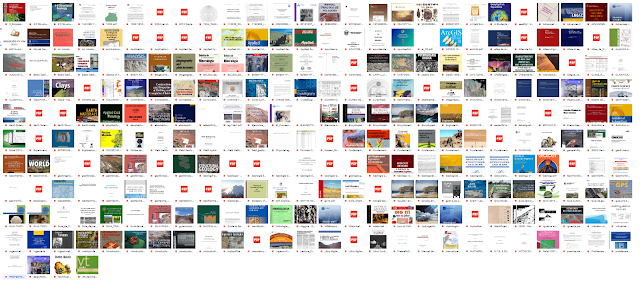martes, 18 de junio de 2019
FGDC Digital Cartographic Standard for Geologic Map Symbolization
Geologic Data Subcommittee
Federal Geographic Data Committee
August 2006
This document provides a single national standard for the digital cartographic representation of geologic map features. This standard is intended to support the Nation's producers and users of geologic map information by providing line symbols, point symbols, and colors and patterns that can be used to portray the various features on geologic maps. The objective of this standard is to aid in the production of geologic maps and related products, as well as to help provide geologic maps and products that are more consistent in both their appearance and their underlying database content.
A geologic map is a cartographic product that expresses information about the geology of a particular area. The map uses graphical elements such as line symbols, point symbols, and colored or patterned areas to portray complex geological information such as the composition, age, genesis, and extent of an area's geologic materials, as well as the geometry, orientation, and character of the geologic structures that have deformed them.
Geologic maps generally are intended for use by both the geoscience professional and the general public; however, designing and preparing a geologic map that will inform such an audience can be a daunting task because of the complexity of both the mapping concepts and the geologic information. The imperative for clear
communication of geologic map information to a diverse audience was outlined early in the history of the U.S. Geological Survey (USGS) by then-Director John Wesley Powell, who stated that "the maps are designed not so
much for the specialist as for the people, who justly look to the official geologist for a classification, nomenclature, and system of convention so simple and expressive as to render his work immediately available alike to the theoretic physicist or astronomer, the practical engineer or miner, and the skilled agriculturist or artisan" (Powell, 1888, p. 229).
The consistent, unambiguous expression of geologic map information is even more critical now because such information increasingly is compiled, stored, manipulated, and exchanged in digital files and geospatial databases. In the digital files, the cartographic representation of each feature on a geologic map must have a unique and explicit meaning, and it also must be compatible with the feature's attributes in the geologic map
database. To that end, the preparers of this standard reviewed existing formal and informal USGS geologic map symbolization standards and adapted them for implementation with modern digital mapmaking systems and
geospatial databases. This standard attempts to facilitate geologic map communication and comprehension by providing clear and familiar symbology, thereby ensuring that the lines, points, and areas on the map convey the same meaning to all information producers and users. This standard also endeavors to clarify some of the concepts of geologic mapping, as well as to standardize some of the terminology used to describe the various features on a geologic map.
Although this standard is herein formalized, it is not intended to be used inflexibly or in a manner that will unduly restrict a geologist's ability to communicate the observations and interpretations gained from geologic mapping. On the contrary, this standard recognizes that, in certain situations, an existing symbol or its usage might need to be modified to fit a particular geologic situation or setting. Likewise, this standard recognizes that a new symbol or set of symbols may need to be created to more fully express local geologic conditions or to keep pace with evolving geologic mapping concepts and practices. Accordingly, such new or modified symbols, if found to be of wide applicability, will be incorporated into this standard through planned, periodic revisions.
Seguidores
GEOFIELD FANPAGE
Entradas Populares
-
MANUAL DE FOTOGEOLOGIA Publicaciones cientificas de la junta de energia nuclear *M. L. LOPEZ VERGARA Fotogeólogo al servicio de l...
-
Depósitos epitermales de alta y baja sulfuración: una tabla comparativa Antoni Camprubí*, Eduardo González-Partida, Gilles Levresse J...
-
Subdivisión de la Placa de Nazca en tres nuevas placas tectónicas y su incidencia con la sismicidad peruana actual* Subdivision of th...
-
MANUAL DE EVALUACION Y DISEÑO DE EXPLOTACIONES MINERAS MADRID 1997 *MANUEL BUSTILLO REVUELTA Doctor en Ciencias Geológicas F...
-
METAMORFISMO Apuntes de la asignatura Petrología Endógena II (Móduo I) *Javier Gómez Jiménez 2006 Metamorphism: a proc...
-
MANUAL DE PROCEDIMIENTON PARA EL REGISTRO GEOTECNICO DE SONDAJES PROYECTO EL CHOCO ESTADO DE BOLÍVAR, VENEZUELA Este docume...
-
LIBROS DE GEOCIENCIAS + DE 500(PRIMERA PARTE) GEOFIELD Comparte la primera parte de LIBROS DE GEOCIENCIAS. Son mas de 500 libros ...
Categories
- DESCARGAS (66)
- GEOLOGIA DE YACIMIENTOS MINERALES (23)
- GEOLOGIA DE CAMPO Y MINAS (19)
- GEOLOGIA ESTRUCTURAL (19)
- PROYECTOS MINEROS (11)
- GEOLOGIA GENERAL (9)
- GEOESTADISTICA - GEOFISICA - SISMOLOGIA - GEOQUIMICA (8)
- GEOMORFOLOGIA (8)
- METALOGENIA (7)
- MINERALOGIA Y CRISTALOGRAFIA (7)
- SEDIMENTOLOGIA Y ESTRATIGRAFIA (7)
- PETROLOGIA IGNEA Y METAMORFICA (5)
- GEOLOGIA DEL PERU (4)
- GEOTECNIA (3)
- GEOTECNIA MINERA (3)
- ESTABILIDAD DE TALUDES (2)
- FOTOGEOLOGIA (2)
- GEOTECTONICA (2)
- BIENVENIDO (1)
- GEOLOGIA DE LOS HIDROCARBUROS (1)
- HIDROGEOLOGIA (1)
- MECANICA DE ROCAS (1)
- PÁGINAS DE GEOCIENCIAS Y MINERÍA (1)
- TOPOGRAFIA MINERA (1)
- VULCANOLOGIA (1)
Blog Archivo
Buscar este blog
Blogroll
ACERCA DE
Con la tecnología de Blogger.
GEOFIELD

GEOFIELD PERU
BUSCAR
LIBROS DE GEOCIENCIAS + DE 500(PRIMERA PARTE)
LIBROS DE GEOCIENCIAS + DE 500(PRIMERA PARTE) GEOFIELD Comparte la primera parte de LIBROS DE GEOCIENCIAS. Son mas de 500 libros ...

Entradas populares
Copyright ©
GEOFIELD | Powered by Blogger
Design by Flythemes | Blogger Theme by NewBloggerThemes.com





























0 comentarios:
Publicar un comentario